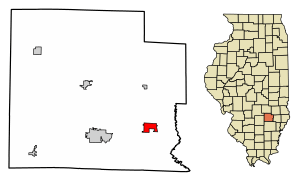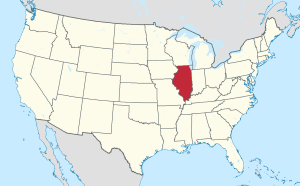Clay City, Illinois facts for kids
Quick facts for kids
Clay City
|
|
|---|---|

Location of Clay City in Clay County, Illinois.
|
|

Location of Illinois in the United States
|
|
| Country | United States |
| State | Illinois |
| County | Clay |
| Area | |
| • Total | 1.78 sq mi (4.61 km2) |
| • Land | 1.78 sq mi (4.61 km2) |
| • Water | 0.00 sq mi (0.00 km2) |
| Population
(2020)
|
|
| • Total | 847 |
| • Density | 475.31/sq mi (183.56/km2) |
| Time zone | UTC-6 (CST) |
| • Summer (DST) | UTC-5 (CDT) |
| ZIP Code(s) |
62824
|
| Area code(s) | 618 |
| FIPS code | 17-14715 |
| Wikimedia Commons | Clay City, Illinois |
| Website | https://www.villageofclaycityil.com/ |
Clay City is a small village located in Clay County, Illinois, in the United States. In 2020, about 847 people lived there. The village got its name from a famous American statesman named Henry Clay.
Contents
Where is Clay City?
Clay City is in the southeastern part of Clay County. It's about 1 mile (1.6 km) southwest of the Little Wabash River. A main road, U.S. Route 50, runs through the southern side of the village. This road can take you about 7 miles (11 km) west to Flora or 15 miles (24 km) east to Olney. Louisville, which is the main town of Clay County, is about 14 miles (23 km) northwest.
The village covers a total area of about 1.78 square miles (4.61 square kilometers), and all of it is land.
Who Lives in Clay City?
In 2020, there were 847 people living in Clay City. There were 356 households, and 239 of them were families. Most people in the village are White (about 97.5%). A small number of people are Native American or Asian, or come from two or more races.
About 28.8% of the people living in Clay City are under 18 years old. The average age of people in the village is about 31.9 years.
The average income for a household in Clay City was about $45,104. For families, the average income was about $49,688.
Clay City's History
Clay City has an interesting past!
Early Settlers
Back in 1810, a man named John McCawley was traveling west from Fort Vincennes along an old path called the Buffalo Trace. When his horse died, he stayed in a cabin near the Little Wabash River. This made him one of the first white settlers in the area. McCawley later built a place called McCawley's Tavern. It was a stop for travelers where they could eat and sleep.
County Formation and Maysville
Clay County was officially created on December 23, 1824. The first court meeting for the new county happened at John McCawley's place in March 1825.
In 1825, Daniel May gave 20 acres (8.1 hectares) of land to the county. This land was a bit west of McCawley's Tavern. This area, once known as Hubbardsville, was renamed Maysville. A small courthouse was built there. Maysville was the county seat until 1841, when the county seat moved to Louisville.
The Railroad and New Beginnings
In 1855, the O&M Railroad was built about 1 mile (1.6 km) north of Maysville. Because of the railroad, a new town called Clay City was started by Mr. J.D. Perkey. It was built north of the tracks. Soon, businesses moved to the south side of the tracks, where they are today. Maysville officially became part of Clay City in 1862.
Clay City became an important trading center for farmers nearby. They could bring their crops to town and trade them for other goods. Passenger trains also made Clay City a transportation hub. Many tourists going to the famous Sailor Springs resort would take the train to Clay City and then travel the rest of the way.
In 1936, oil was found in the area! Today, businesses related to oil are still an important part of Clay City.
Famous People from Clay City
- Hal Wiltse: He was a professional baseball pitcher who played for teams like the Boston Red Sox and Philadelphia Phillies. He was born in Clay City.
- Bernardine Flynn: She was a radio and television actress, famous for the "Vic & Sade" radio show. She later retired and lived in Clay City.
See also
 In Spanish: Clay City (Illinois) para niños
In Spanish: Clay City (Illinois) para niños

